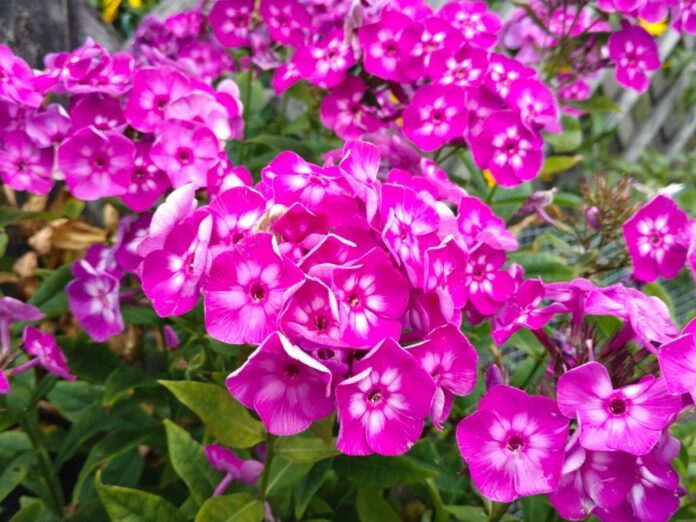Introduction
Phlox, a genus of flowering plants in the family Polemoniaceae, is a beloved staple in many gardens. Known for its vibrant blooms and versatility, it offers a burst of color and fragrance throughout the growing season. This article delves into the various species of it, their ideal growing conditions, and tips on how to incorporate these stunning flowers into your landscape.
What is Phlox?
Phlox encompasses a wide range of species, from ground-hugging varieties to tall, elegant plants that command attention in the garden. Originating from North America, these perennials and annuals are prized for their star-shaped flowers, which come in a variety of colors including pink, red, white, purple, and even bicolors.
Different Species of Phlox
Phlox is a diverse genus with several species that are popular among gardeners:
Creeping Phlox (Phlox subulata):
This low-growing, mat-forming species is perfect for ground cover. Creeping phlox blooms in early spring, creating a carpet of color that spreads across the garden. It’s ideal for rock gardens, borders, and slopes, where it can prevent soil erosion.
Garden (Phlox paniculata):
Known for its tall stature and large clusters of fragrant flowers, the garden phlox is a classic choice for perennial borders. Blooming from mid-summer to early fall, it attracts pollinators like butterflies and hummingbirds, making it a great addition to wildlife-friendly gardens.
Woodland Phlox (Phlox divaricata):
This species thrives in shady areas, making it a perfect choice for woodland gardens. Woodland it offers delicate, fragrant flowers in shades of blue, violet, and white, blooming in the spring. Its ability to thrive in low light conditions makes it invaluable for areas under trees or along shaded paths.
Growing Conditions for Phlox
it is relatively easy to grow, provided that you match the species to the right growing conditions. Here’s what you need to know:
Soil:
It is generally prefers well-drained soil with a pH ranging from slightly acidic to neutral. Garden phlox, in particular, benefits from rich, organic soil that retains moisture without becoming waterlogged.
Sunlight:
The light requirements for phlox vary by species. Garden phlox thrives in full sun, needing at least six hours of direct sunlight each day to bloom profusely. On the other hand, woodland it prefers partial shade and can suffer from leaf scorch if exposed to too much direct sunlight.
Watering:
While phlox requires consistent moisture, it’s essential to avoid waterlogged conditions. Water regularly, especially during dry spells, to keep the soil evenly moist. Mulching around the base of the plants can help retain moisture and keep the roots cool.
Incorporating Phlox into Your Garden Design
Phlox’s versatility makes it a fantastic addition to various garden styles. Here’s how you can incorporate it into your landscape:
Rock Gardens:
Creeping phlox is ideal for rock gardens. Its low-growing habit and vibrant colors create a stunning display against the rugged texture of stones. Plant creeping in pockets between rocks, where it can cascade down, softening hard edges.
Perennial Borders:
Garden height and bold flowers make it a standout in perennial borders. Pair it with other sun-loving perennials like coneflowers, black-eyed Susans, and daylilies for a long-lasting display of color.
Woodland Gardens:
For a serene woodland garden, plant woodland alongside ferns, hostas, and astilbes. Its delicate flowers add a touch of color to shady areas, while its fragrance enhances the peaceful ambiance of the garden.
Phlox Care and Maintenance
It is relatively low-maintenance, but there are a few tasks that can keep your plants healthy and blooming:
Deadheading:
Remove spent flowers to encourage more blooms and prevent the plants from self-seeding. This also helps maintain the plant’s neat appearance.
Dividing:
Every few years, divide the garden phlox to prevent overcrowding and to rejuvenate the plants. This is best done in the spring or early fall.
Pest and Disease Management:
It is susceptible to powdery mildew, especially in humid conditions. To prevent this, ensure good air circulation around the plants by spacing them properly and avoiding overhead watering. If powdery mildew does appear, treat it with a fungicide or remove the affected leaves.
The Ecological Benefits of Phlox
It is not just beautiful; it also plays a vital role in supporting local ecosystems:
Pollinator Attractant:
Phlox flowers are a magnet for bees, butterflies, and hummingbirds. By planting phlox in your garden, you’re providing a valuable nectar source for these pollinators, which in turn helps your garden thrive.

Soil Health:
Creeping phlox, in particular, helps prevent soil erosion on slopes and hillsides. Its dense mat of roots holds the soil in place, reducing the risk of landslides and runoff.
Popular Phlox Varieties to Consider
There are many phlox varieties to choose from, each with its unique charm:
‘David’ (Phlox paniculata):
This variety is known for its pure white flowers and resistance to powdery mildew. It’s a tall variety, reaching up to four feet in height, and blooms from mid-summer to early fall.
‘Emerald Pink’ (Phlox subulata):
A creeping phlox variety, ‘Emerald Pink’ produces vibrant pink flowers in early spring. It’s a compact plant, growing only a few inches tall, but spreads widely, making it perfect for ground cover.
‘Blue Moon’ (Phlox divaricata):
‘Blue Moon’ is a woodland phlox variety with striking lavender-blue flowers. It’s a fragrant, low-growing plant that thrives in shady areas and blooms in early spring.
Conclusion
Phlox is a versatile and beautiful addition to any garden, offering color, fragrance, and ecological benefits. Whether you’re looking to add ground cover, brighten up a perennial border, or enhance a woodland garden, there’s a species that’s perfect for your needs. With the right care and attention, It will reward you with stunning blooms year after year, making it a favorite among gardeners of all skill levels.


